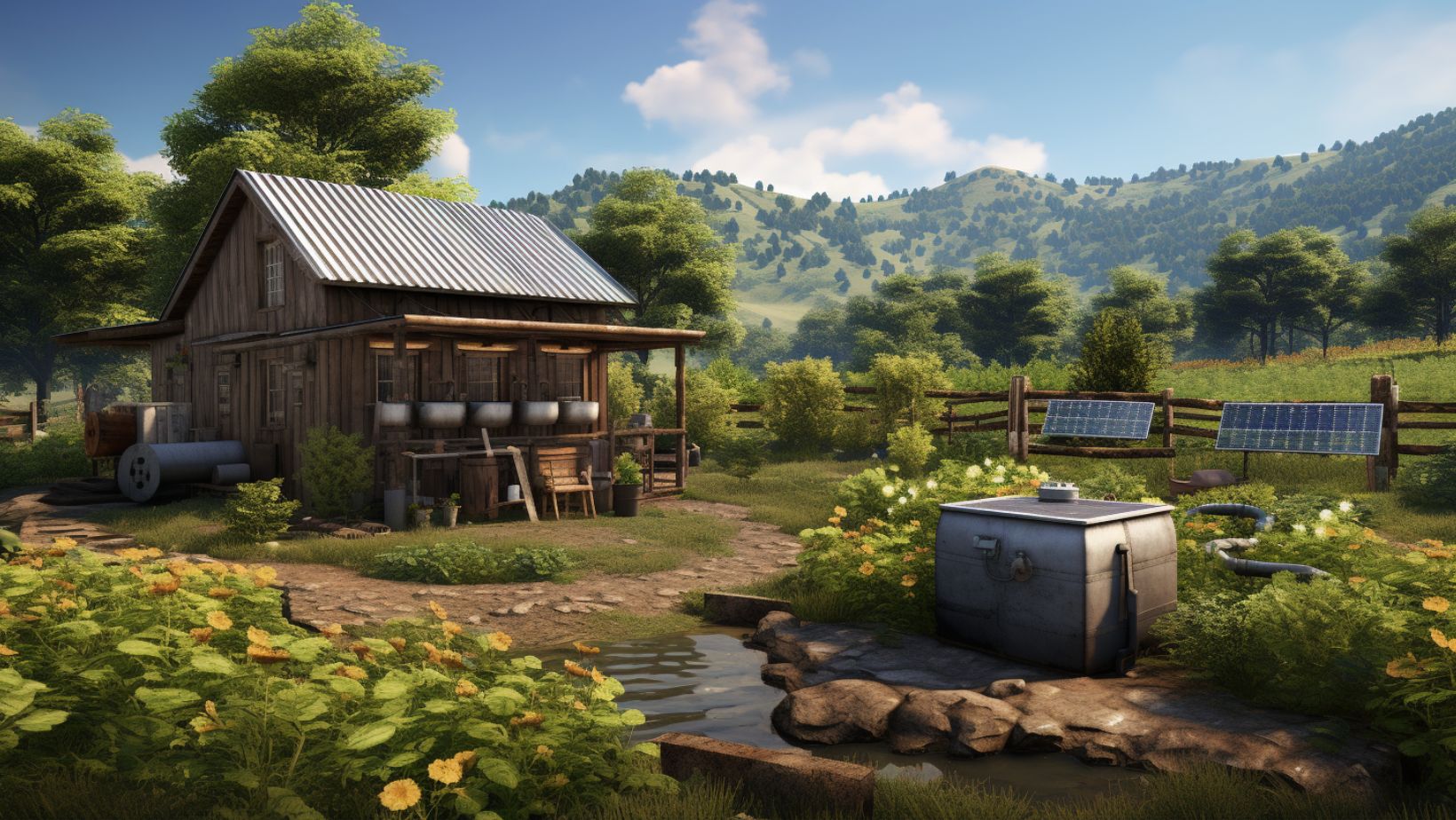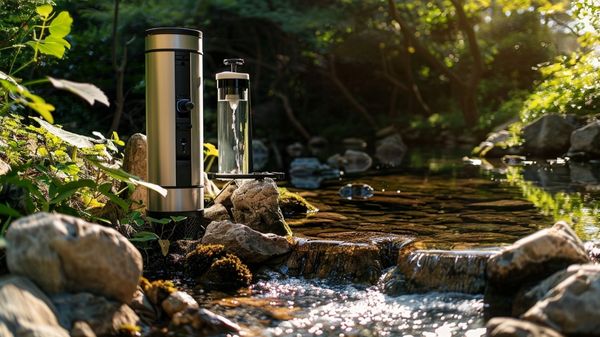Are you ready to take the plunge into sustainable living? Look no further! This article “The Off-Grid Water System: The Ultimate Guide for Sustainable Living” is here to help you navigate the world of off-grid water sources and waste water disposal.
Say goodbye to the limitations of traditional water systems and embrace the freedom of a gravity-fed household water system. With our comprehensive guide and handy tools, setting up your own off-grid water system has never been easier. Get ready to belong to a community of like-minded individuals who are taking control of their water supply.
Key Takeaways
- Water Source: Identify a sustainable and abundant water source, such as a natural spring, well, or rainwater collection system. This will ensure a consistent supply of water for your off-grid system.
- Filtration and Purification: Implement a reliable filtration and purification system to remove any contaminants and ensure the water is safe for consumption. This can include using filters, UV sterilizers, or even distillation methods.
- Storage and Distribution: Properly store and distribute the water throughout your property. Utilize storage tanks, gravity-fed systems, or pumps to ensure water is readily available when needed.
- Well water systems are a sustainable and efficient solution for accessing clean water in remote locations.
- Lake water systems can be a sustainable and cost-effective option for off-grid living.
- Rainwater systems provide a sustainable water source for off-grid living, especially during dry seasons.
- Proper filtration and sterilization ensure clean and safe water for consumption in off-grid water systems.
Off-Grid Water Sources
If you’re looking for sustainable off-grid water sources, there are a few key options to consider.
- Well water systems involve drilling a well and using a pump to draw water from underground.
- Lake water systems utilize a filtration and purification system to make lake water safe for consumption.
- Rainwater systems collect and store rainwater for various uses, such as irrigation and household needs.
Each of these options has its own benefits and considerations, and understanding them can help you make an informed decision for your off-grid water needs.

Well Water System
To set up your well water system, you’ll need to consider the installation process and the importance of an off-grid power system to operate the pump. An off-grid water system allows you to access clean and sustainable water even in remote locations.
Here are three key components to consider for your well water system:
- Off-Grid Water System Diagram: A well water system typically includes a drilled well, a submersible pump, a pressure tank, and a supply line. You can create a diagram to visualize how these components connect and ensure a smooth installation.
- Off-Grid Water Filtration System: It’s essential to incorporate a reliable water filtration system into your off-grid setup. This will help remove impurities and ensure the water you access from your well is safe and clean for drinking and household use.
- Off-Grid Water Pump System: To operate the pump, you’ll need an off-grid power system. This can include solar panels, wind turbines, or a combination of renewable energy sources. This will ensure a constant and reliable power supply to pump water from your well.
Setting up a well water system with an off-grid power system is a sustainable and efficient solution for accessing clean water in remote locations.
Lake Water System
Installing a primary filter and purification system ensures safe drinking water from lake sources. When setting up an off-grid water system for your cabin, using lake water as a source can be a sustainable and cost-effective option.
To begin, you will need a large diameter pipe that extends from the lake to your cabin. A jet pump can then be installed to draw water from the lake and supply it to your cabin.
It is important to obtain the necessary permits before proceeding with the installation. Once the water reaches your cabin, installing a primary filter will remove larger particles and sediment, while a purification system will eliminate any harmful bacteria or contaminants, ensuring clean and safe drinking water.
Remember to regularly maintain and clean these systems to ensure their effectiveness. With an off-grid water system utilizing lake water, you can enjoy a sustainable and reliable water source for all your needs.
| # | Preview | Product | Rating | Price | |
|---|---|---|---|---|---|
| 1 |

|
Bluevua RO100ROPOT-UV Reverse Osmosis System Countertop Water Filter - 6 Stage Purification with... |
$454.00
$317.00 |
Buy on Amazon | |
| 2 |

|
iSpring RCC7AK, NSF Certified, 75 GPD, Alkaline 6-Stage Reverse Osmosis System, pH+... |
$279.00
$198.79 |
Buy on Amazon |
Rainwater System
When setting up your rainwater system for your cabin, it’s important to consider the collection and filtration process. To build an off-grid water system that provides a sustainable water source, follow these steps:
- Install a storage tank on your cabin’s roof to collect rainwater. This ensures that you have a sufficient supply, especially during dry seasons.
- Use a filtration system to remove impurities from the collected rainwater. This can include using a sediment filter, activated carbon filter, and UV sterilizers to ensure the water is safe for consumption.
- Set up a pump system to distribute the filtered rainwater to your indoor plumbing. This will allow you to use the water for various purposes such as drinking, cooking, and showering.
Related Article: 10 Reliable Off Grid Water Systems for Your Property.
Moving Water and Waste Water Disposal
One option for moving water in off-grid systems is to use a manual pump. This method allows you to access water without relying on electricity or other power sources. To build your own off-grid water filter system, you will need a few essential components. Here’s a table that outlines the materials and steps involved:
| Materials Needed | Steps to Build |
|---|---|
| Filter housing | 1. Attach the filter housing to the water source. |
| Sediment filter | 2. Install a sediment filter to remove larger particles. |
| Carbon filter | 3. Add a carbon filter to remove impurities and odors. |
| UV sterilizer | 4. Install a UV sterilizer to kill any remaining bacteria. |
| Storage container | 5. Connect the system to a storage container for clean water. |
Off-Grid Toilets
Using composting toilets or propane-powered incinerating toilets are alternative options for off-grid toilet solutions. These options provide sustainable and eco-friendly alternatives to traditional toilets. Here are three reasons why you should consider these off-grid toilet options:
- Composting toilets: These toilets use the natural process of decomposition to break down waste into nutrient-rich compost. They require little to no water, making them perfect for off-grid living. Composting toilets are odorless and can be easily maintained, providing a hassle-free solution for waste management.
- Propane-powered incinerating toilets: These toilets use propane gas to incinerate waste, reducing it to a small amount of ash. They are clean and efficient, eliminating the need for water or plumbing. Propane-powered incinerating toilets are compact and can be easily installed in off-grid locations.
- Outhouses: Outhouses are a traditional and rustic option for off-grid toilet solutions. They are simple to construct and do not require any electricity or plumbing. Outhouses are an environmentally friendly option, as waste is naturally broken down in the soil.
Related Post: Ultimate Guide To Septic Tanks and Septic System Maintenance.
Benefits of Gravity-Fed Household Water
Gravity-fed water systems offer numerous advantages. They save you time and labor and reduce the need for water hauling. With this system, you have a reliable and sustainable water source at your fingertips. You don’t have to rely on electricity or pumps to get water to your home; gravity does all the work for you. This means less maintenance, fewer breakdowns, and more peace of mind.
Additionally, gravity-fed systems are cost-effective and environmentally friendly. They require minimal energy input and can be easily integrated into off-grid living. By harnessing the power of gravity, you can have a constant supply of water without the hassle and expense of traditional water systems.
It’s a practical and efficient solution for those seeking self-sufficiency and belonging to a sustainable community.
Tools and Materials for Setting Up an Off-Grid Water System
Now that you understand the benefits of a gravity-fed household water system, it’s time to delve into the tools and materials you’ll need to set up your own off-grid water system. Don’t worry, we’ve got you covered! Here are the essential items:
- Level: Ensure the accuracy of your construction and installation process.
- Dirt: Use it to create a solid foundation for your water tank platform.
- Grade stakes and plywood: These will help you build the platform for the water tank using a concrete slab.
By having these tools and materials ready, you can ensure a smooth and efficient setup of your off-grid water system. With the right foundation, you’ll be well on your way to sustainable living.
Bicycle Wheel Water Lifter
By having the necessary tools and materials, you can easily set up a bicycle wheel water lifter for moving water without a pump. This simple solution is perfect for those who desire a sustainable and off-grid water system.
To create a bicycle wheel water lifter, you will need a large bicycle wheel and a hose. Start by attaching the hose to the rim of the bicycle wheel using zip ties or strong tape. Position the bicycle wheel vertically on a stand or frame, making sure it is stable and secure.
Lower the wheel into a water source, such as a well or a pond, and rotate it manually. As the wheel turns, it will scoop up water and lift it through the hose, allowing you to divert it to where it is needed.
Keep in mind that the distance and volume of water that can be lifted using this method may be limited, so consider your specific needs and resources.
With a bicycle wheel water lifter, you can have a sustainable and efficient way to move water without relying on a traditional pump.
Related Post: Free Energy Generator: Unveiling the Myths and Possibilities.
Frequently Asked Questions
Can an Off-Grid Water System Be Used in an Urban Area or Is It Only Suitable for Rural Settings?
You can definitely use an off-grid water system in an urban area! It’s not just for rural settings. These systems provide a sustainable water source and can be tailored to fit the unique needs of an urban environment.
How Much Maintenance Is Required for an Off-Grid Water System?
Maintaining an off-grid water system requires regular check-ups and occasional repairs. Don’t fret, though! With a little TLC and some basic knowledge, you’ll be able to keep your system running smoothly and enjoy sustainable living.
Is It Possible to Filter and Purify Rainwater for Drinking Purposes in an Off-Grid Water System?
Yes, it is possible to filter and purify rainwater for drinking purposes in an off-grid water system. By using a combination of filtration methods like sediment filters, activated carbon filters, and UV sterilization, you can ensure safe drinking water.
Can an Off-Grid Water System Be Integrated With Existing Plumbing Infrastructure in a Conventional Home?
Sure, you can integrate an off-grid water system with existing plumbing infrastructure in a conventional home. It’s a practical solution for sustainable living, ensuring you have access to clean water while reducing your reliance on external resources.
Are There Any Legal Restrictions or Permits Required for Setting up an Off-Grid Water System?
To set up an off-grid water system, you may need to consider legal restrictions and permits. Check with your local authorities to ensure compliance and obtain any necessary permits before starting your sustainable living journey.
Conclusion
So there you have it, the ultimate guide to setting up an off-grid water system for sustainable living. By utilizing natural sources of water and implementing efficient waste water disposal methods, you can truly live off-grid and reduce your environmental impact.
Did you know that according to a study conducted by the United Nations, around 2.2 billion people worldwide lack access to safe drinking water? By adopting an off-grid water system, you are not only ensuring your own water security, but also contributing to a more sustainable future for all.
So go ahead, take the plunge and start living off-grid with your own self-sufficient water system!






